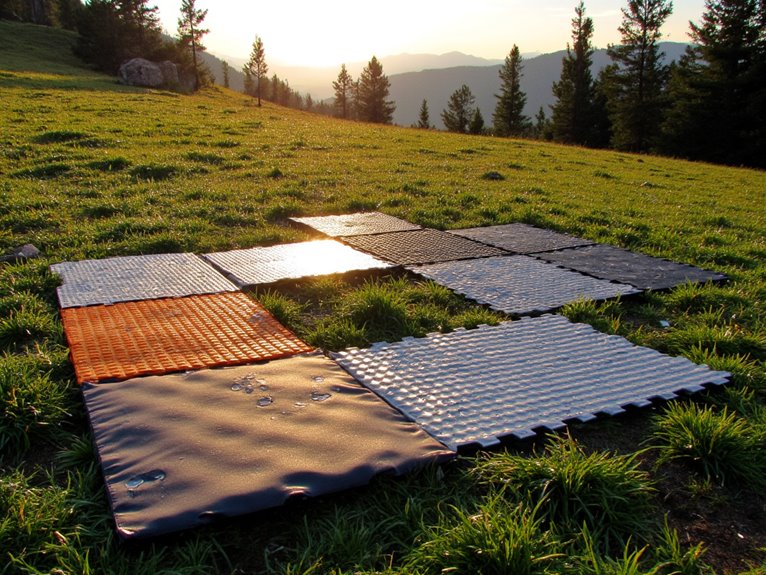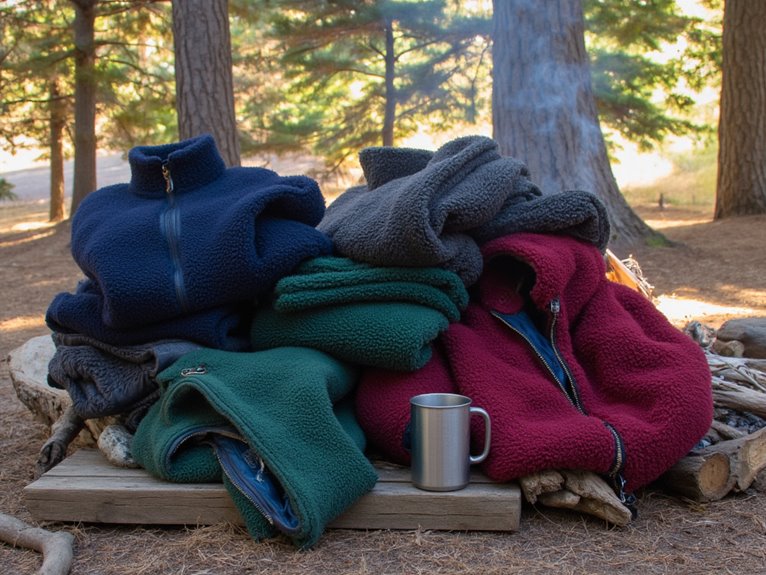Clothing Layers for Sleep: Choosing Base & Mid-Layers for Overnight Use
You’ll need moisture-wicking base layers and insulating mid-layers for ideal sleep comfort. Choose merino wool or polyester base layers since they regulate temperature and wick sweat effectively—avoid cotton completely. Polyester dries 40% faster than wool, while merino offers superior warmth-to-weight ratios. Add fleece or synthetic mid-layers when temperatures drop below 64°F. This layering system can extend your sleeping bag’s temperature rating by 10-15°F through strategic combinations that adapt to changing nighttime conditions.
We are supported by our audience. When you purchase through links on our site, we may earn an affiliate commission, at no extra cost for you. Learn more. Last update on 14th December 2025 / Images from Amazon Product Advertising API.
Notable Insights
- Choose merino wool or polyester base layers for optimal moisture wicking and temperature regulation during sleep.
- Avoid cotton base layers as they retain moisture and cause discomfort throughout the night.
- Add fleece or wool mid-layers in temperatures below 64°F to maintain warmth and insulation.
- Use multiple thin layers instead of thick garments for precise temperature control and easy adjustments.
- Select materials that wick sweat effectively to prevent dampness and maintain consistent overnight comfort.
Understanding Base Layer Fundamentals for Nighttime Comfort
When you’re selecting sleepwear for peak comfort, your base layer becomes the most critical component of your sleep system. This foundational garment directly contacts your skin and manages moisture throughout the night.
Different fabric types offer varying performance characteristics for nighttime use. Merino wool provides natural odor resistance and temperature regulation. Synthetic materials like polyester excel at quick-drying properties.
The base layer’s primary function centers on moisture control—moving perspiration away from your body to prevent chilling. A proper fit maximizes this transfer while avoiding restriction during sleep movements.
Lightweight fabrics work best for most climates, reducing bulk while maintaining breathability. Your base layer also protects bedding from body oils and sweat, extending the life of your sleep system.
Selecting the Right Materials for Sleep Base Layers
Your choice of base layer material directly determines how well you’ll sleep through the night. Material properties affect temperature regulation, moisture management, and overall comfort during extended rest periods.
The right base layer material is the difference between restful sleep and a restless night of temperature struggles.
Polyester excels in moisture wicking and dries 40% faster than wool, making it ideal for warm sleepers. Merino wool provides superior warmth-to-weight ratios and natural odor resistance through antimicrobial properties. However, wool retains moisture, which creates problems in cold conditions.
Key material considerations for sleep base layers:
- Polyester blends: Best moisture management and breathability
- Merino wool: Superior temperature regulation and odor control
- Silk: Maximum softness but reduced durability
- Cotton: Poor moisture wicking, unsuitable for base layers
- Nylon blends: Enhanced durability and pilling resistance
Synthetic materials offer better airflow during sleep, while natural fibers provide comfort advantages.
Mid-Layer Functions and Benefits During Sleep
Base layers handle moisture transport and skin contact, but mid-layers serve a completely different role in your sleep system.
Mid-layers focus on insulation retention and temperature regulation through trapped air pockets. These layers prevent convective heat loss while managing moisture vapor transfer away from your body.
Mid layer benefits include flexible temperature control and reduced heat loss in cold environments. You can add or remove these layers as temperatures change throughout the night.
Mid layer materials like polyester fleece, merino wool, and synthetic insulation each offer specific performance characteristics. Polyester fleece provides lightweight breathability, while merino wool delivers natural anti-bacterial properties and moisture management.
Synthetic insulation maintains warmth even when damp, making it ideal for humid conditions.
Adapting Your Layering System to Temperature Changes
Your layering system needs quick adjustments when temperature drops catch you off guard during sleep, requiring strategic addition of mid-layers like fleece or lightweight down over your moisture-wicking base layer.
You’ll also face the opposite challenge when overnight warming creates overheating risks that demand immediate layer removal to prevent sweat accumulation and subsequent chilling.
These temperature fluctuations require a planned approach to layer management that lets you adapt your sleep clothing without fully waking or disrupting your rest cycle.
Temperature Drop Adjustments
When nighttime temperatures fluctuate, effective sleep clothing requires a dynamic layering system that responds to your body’s natural thermal patterns.
Your core body temperature drops to its lowest point between 1-7 am during your sleep cycle, while peripheral temperature in hands and feet follows an opposite pattern.
Strategic adjustments prevent night waking caused by temperature fluctuations:
- Base Layer Modifications: Switch to long-sleeved bodysuits when ambient temperature drops below 64°F (18°C)
- Sleep Sack Upgrades: Increase TOG ratings from 1-2.5 to higher insulation values for colder conditions
- Peripheral Protection: Add mittens and socks when temperatures fall below 50°F (10°C)
- Ventilation Balance: Maintain airflow while preventing heat loss through strategic layer adjustments
- Fabric Selection: Choose moisture-wicking materials that adapt to temperature changes throughout the night
Overheating Prevention Strategies
Overheating poses the greatest temperature-related risk during infant sleep, requiring a systematic approach to layer reduction rather than layer addition.
Your layering techniques should prioritize heat dissipation over warmth retention. Remove one layer when room temperature exceeds 72°F. Never use hats or head coverings indoors, as 40% of body heat escapes through the head.
Monitor your baby’s chest or back of neck for temperature assessment. Warm, sweaty skin indicates immediate layer removal. Choose cotton base layers over synthetic materials for superior breathability.
Your seasonal adjustments should follow the one-additional-layer rule compared to adult comfort levels.
Maintain room temperature between 68-72°F using your thermostat. Select sleep sacks with appropriate TOG ratings: 0.5 TOG for summer, 1.0 TOG for moderate temperatures, 2.5 TOG maximum for winter conditions.
How Sleeping Bag Ratings Work With Layering Systems
Your sleeping bag’s temperature ratings assume you’re wearing minimal clothing and using proper ground insulation, but these standardized test conditions don’t match real-world camping scenarios.
The EN and ISO rating systems provide three key thresholds—Comfort, Lower Limit, and Extreme—that serve as baselines you can adjust through strategic layering.
Understanding how your clothing layers interact with these ratings lets you extend your bag’s effective temperature range and compensate for personal factors like gender differences and individual metabolism.
The type of insulation construction in your sleeping bag—whether down, synthetic, or hybrid—affects how effectively your body heat transfers through clothing layers and determines the optimal layering strategy for different conditions.
Temperature Rating Assumptions
Understanding sleeping bag temperature ratings requires recognizing that manufacturers base these numbers on specific assumptions about what you’ll wear inside the bag. These sleeping bag ratings follow ISO 23537 testing standards using heated manikins in controlled environments.
However, real-world performance depends heavily on your layering choices and environmental conditions. The standardized testing assumes specific conditions that may not match your actual camping situation:
- Base layer clothing worn during testing (typically lightweight synthetic materials)
- Controlled humidity levels around 50-60% relative humidity
- No wind exposure or ground temperature variations
- Average cold sleeper metabolism and body heat production
- Specific sleeping pad R-values for ground insulation
Temperature thresholds shift considerably when you deviate from these assumptions.
Adding insulating layers can extend your bag’s effective range by 10-15°F, while inadequate ground insulation or wind exposure reduces performance substantially.
Layering System Adjustments
Sleeping bag ratings work as baseline measurements that change considerably when you add or remove clothing layers inside your bag.
The ISO 23537 testing protocol assumes only thin base layers, but real-world conditions often require adjustments. Adding a fleece mid-layer can effectively lower your bag’s usable temperature rating by 5-10 degrees Fahrenheit.
Your layering fabrics directly impact warmth retention and moisture management.
Merino wool base layers wick sweat while maintaining insulation when damp. Synthetic mid-layers like fleece provide consistent warmth even if wet. Down jackets offer maximum warmth-to-weight ratios but lose effectiveness when moisture accumulates.
You’ll need different layering strategies depending on whether you’re a warm or cold sleeper.
Cold sleepers should prepare mid-layers when approaching the comfort rating, while warm sleepers can rely on base layers near the limit rating.
Practical Strategies for Effective Nighttime Layering
When building an effective nighttime layering system, you’ll achieve ideal temperature control by combining multiple thin layers rather than relying on a single thick garment. This approach allows precise adjustments throughout the night as your body temperature fluctuates during different sleep phases.
Your layering techniques should adapt based on seasonal conditions and activity levels. Consider these essential strategies:
- Seasonal adjustments: Use thicker base layers and insulating mid-layers during colder months.
- Activity-based modifications: Reduce layers if you’re physically active before sleep to prevent overheating.
- Moisture management priority: Ascertain all layers work together to wick sweat efficiently.
- Personal preferences integration: Choose materials and weights that match your comfort requirements.
- System flexibility: Select layers that can be easily added or removed during the night.
Remember that your clothing layers work in conjunction with your sleeping pad’s insulation to create a complete thermal barrier against ground contact and heat loss.





